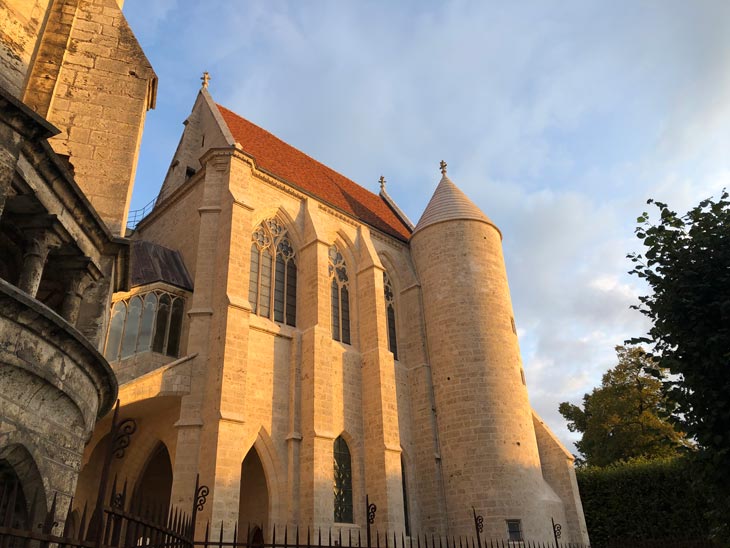The Cathedral Treasury
Expected since the early 2000s, the reopening of the cathedral’s treasury is one of the major projects underway in the building. Begun in 2019 with the exterior restoration of the Saint-Piat chapel, including the restoration of the medieval windows of the upper chapel, and the creation of four contemporary windows for the chapter house, this project is currently being pursued with the restoration of the chapel’s interiors; it will continue with the installation of the museographic furniture and the works of art that make up the treasure.
It is planned to open to the public by the end of 2022.
Traditionally, the term “treasure” refers to precious objects used for the exercise or adornment of worship, as well as for the veneration of relics.
In Chartres, the treasure was built up around insignia relics such as the heads of St. Anne or St. Matthew, but one of the pillars of the foundation and growth of the treasure of Notre-Dame is undoubtedly the relic of the veil of the Virgin, known as the Holy Shirt before the 18th century (Sancta Camisia). Preciously preserved in the Holy Shrine since the tenth century, the relic has indeed attracted many pilgrims and generous donations to Chartres. The Sainte-Châsse itself was progressively enriched with various ornaments: jewels, precious stones, bracelets, or more modestly pilgrimage signs. The Romanesque statue of Notre-Dame Sous-Terre or that of Notre-Dame du Pilier, offered to the cathedral by one of its canons at the beginning of the 16th century, also attracted offerings, among which were rich robes intended to adorn the sculptures.
If the treasure has known ups and downs throughout its existence, it was the Revolution that constituted the most radical break: almost all the goldsmith’s work and part of the textiles were seized and melted down to recover the gold and silver. Many reliquaries were desecrated and their contents dispersed.
After the Concordat and throughout the 19th century, the treasure was slowly reconstituted thanks to the commissioning of religious objects and various donations, notably encouraged by the fire of the roof structure in 1836.
Today, the treasure of Chartres Cathedral is, like many cathedral treasures in France, a “recomposed” treasure, with some pieces from the historical treasure and others integrated since the Revolution. Then as now, the treasure remains a living whole that is still being enriched today, as shown by the recent creations of the goldsmith Goudji for the divine service.
Among the pieces of this treasure that will soon be presented in the Saint-Piat chapel, we can mention for example:
Virgin and Child
Deposit of the Federation of the Carmelites of France, this Virgin and Child in wood of the XVIIth century is one of the oldest and most faithful copies of the Romanesque statue venerated in the chapel Notre-Dame-Sous-Terre under the Ancien Régime.

Incense shuttle of Miles d’Illiers
This silver and nautilus shell shuttle was offered to the cathedral in 1540 by Miles d’Illiers, bishop of Luçon and dean of Chartres. It is presented as a nave with a fire-breathing dragon’s head as its figurehead.

Ex-voto
Among the most outstanding ex-votos offered in the past to the cathedral and still preserved today are medieval armors of royal children or two belts made of shell beads offered at the end of the 17th century by the Huron and Abenaki Amerindian tribes, evangelized by French missionaries.


Tabernacle of Saint-Aignan
Acquired in 1806, this probable reliquary, known as the Tabernacle de Saint-Aignan, dates from around 1200. Its oak core is covered with gold leaves on which are copper medallions decorated with angels. The shutters are made of copper plates in Limousin champlevé enamels from the 13th century and are adorned with gilded copper applique figures representing the Apostles receiving the Holy Spirit on the day of Pentecost. Other applique figures are found inside, including a Crucifixion on the back plate.

Liturgical Ornaments
Chartres Cathedral still possesses some ornaments from the Ancien Régime, but the majority of the textiles preserved today date from the 19th and 20th centuries. Sets of chaps, chasubles, stoles, and maniples in the colors of the different times of the liturgical year make up this sacred vestment, which was intended primarily for the celebration of the Eucharist.

Vestments for statues
The statues of Notre-Dame Sous-Terre and Notre-Dame du Pilier possessed, under the Ancien Régime, numerous robes intended for their adornment. One of the robes of the Romanesque Virgin, dated from the 14th century, is still preserved today, as is a robe of Our Lady of the Pillar, probably embroidered by the Carmelites of Chartres in the 17th century.

Irène Jourd’heuil, curator of Historic Monuments
the use or reproduction of all the photos of this page is not authorized
© Service patrimoine et inventaire de la région Centre-Val de Loire

The Saint-Piat Chapel
In the 14th century, in the axis of the chevet of the cathedral of Notre-Dame de Chartres, a chapel was built to receive the relics of Saint Piat.
In 1961, this chapel was assigned to the presentation of the cathedral’s treasure…






